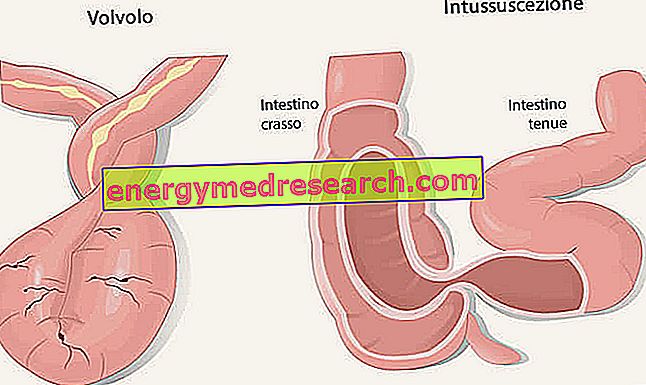Generality
Intussusception is the phenomenon by which a portion of intestine slips inside another portion of the immediately adjacent intestine.
Intussusception is a serious medical condition that requires timely treatment if the worst is to be avoided (intestinal blockage followed by intestinal perforation).
The phenomenon of intussusception is more common in young individuals than in adult subjects. In young people, its causes are often unknown; in adults, on the other hand, its triggering factors are always clearly identifiable and consist of conditions such as intestinal polyps, intestinal adhesions, Crohn's disease and intestinal tumors.
The typical symptoms of intussusception are: abdominal pain, nausea, vomiting, mixed stools with blood and mucus, fever, diarrhea and lethargy.

What is the intussusception?
Intussusception is a serious medical condition, characterized by the invagination (or prolapse) of a section of intestine within an adjacent section of intestine (this is usually a portion located downstream).
To better understand the phenomenon of intussusception, think of the telescopes once used for navigation and their mechanism of lengthening and shortening, based on a composition with segments of increasing diameter that slide one inside the other.
In the intussusception the same thing happens during the shortening of these telescopes: during the shortening of these instruments, the smaller segments are inserted inside the larger segments in a way very similar to how, during the intussusception, a section of intestine slips (in medical jargon, it is said that it "prolapses") inside a portion of the neighboring intestine.
Which part of the intestine most frequently strikes?
Intussusception can take place in any part of the intestine.
However, it is a fact that it has a predilection for the small intestine and, specifically, for the portion immediately before the large intestine, ie the ileum .
Remaining always at the level of small intestine, another stretch of the latter predisposed to intussusception is the so-called fasting .
Because she is famous?
Intussusception is a phenomenon that owes its notoriety to being the main cause of intestinal blockage (or bowel obstruction ) in children from 6 months to 3 years of age.
Epidemiology
A rare phenomenon in general, intussusception most frequently affects subjects of very young age, namely infants and children.
According to some studies, his favorite victims would be subjects under the age of 2 years: in these individuals, the probability of intussusception begins to become concrete shortly before the 4th / 5th month of life, reaches its peak at 9 Month of life and progressively declines with the arrival of the 18th month of life.
In adult individuals, the phenomenon of intussusception is quite rare.
Origin of the name
The term intussusception derives from the union of two Latin words, which are: intus and suscipere . The word " intus " means "inside", while the word " suscipere " means "to welcome".
Therefore, the literal meaning of intussusception is "to accept within".
Causes
The phenomenon of intussusception on young and very young subjects is due, in 90% of the cases, to unknown or unidentifiable causes and, only in the remaining 10% of the circumstances, to causes that are easily recognizable and definable. Among the latter, they include:
- Meckel's diverticulum . It is a congenital anatomical defect of the small intestine;
- Intestinal polyps ;
- Intestinal duplication . It is a rare congenital malformation of the gastrointestinal tract, characterized by the abnormal presence, generally within the small intestine, of one or more cysts;
- Hyperplasia on Peyer's plates .
In adults, the situation is very different and intussusception is always linked to very precise and recognizable causes. More specifically, the phenomenon of adult intussusception can be the result of medical conditions - including Crohn's disease, intestinal polyps, abdominal adhesions of the intestine and intestinal tumors - or of surgical procedures - as per example the gastric bypass and all the surgical interventions that have as their object the intestine.
Risk factors
The main risk factors of intussusception include:
- The young and very young age;
- Membership in the male sex;
- The presence of congenital malformations of the intestine;
- A previous history of intussusception;
- A family history of intussusception.
Symptoms, signs and complications
Intussusception in young and very young
In infants and young children, the intussusception can be responsible for:
- Abdominal pain;
- Feces mixed with blood and mucus ("faeces in currant jelly");
- He retched;
- Abdominal swelling;
- Lethargy and drowsiness;
- Diarrhea;
- Temperature.
Not all patients of young and very young age fully manifest the aforementioned symptomatology: in some cases, the stools have the normal appearance and do not show any abdominal swelling; in other cases (particularly among older children), only abdominal pain is present; in other cases, finally, the intussusception is responsible for symptoms so little perceptible, to be passed almost unnoticed by the patient himself.
HOW TO RECOGNIZE THE ABDOMINAL PAIN IN INFANTS?
Very young children are unable to communicate the presence of abdominal suffering - as adults are capable - however they manage to make themselves understood, through crying and crying their knees to the chest (this movement is, for them, reason for pain relief).
HOW DOES THE ABDOMINAL PAIN PRESENT IN NEWBORN AND CHILDREN?
In newborns and very young children with intussusception, abdominal pain comes and goes, that is, it is intermittent.
Initially, this intermittence leads to painful crises every 15-20 minutes; over time, however, it worsens and patients experience pain more frequently and for longer periods.
Symptoms of intussusception of the adult individual
In adults, the most common symptoms and signs of intussusception are:
- Abdominal pain that comes and goes;
- Nausea;
- He retched.
It should be pointed out that, often, in adult patients, the intussusception is difficult to recognize, as it derives from pathological conditions which, with other more intense symptoms, cover its presence.
When should I go to the doctor?
The phenomenon of intussusception requires the immediate intervention of a doctor. Therefore, at the first symptoms and suspicious signs, it is good to turn to those responsible and to go to the nearest hospital center.
It is recalled that, in children, the typical behaviors that express the presence of abdominal pain are crying and the tendency to curl up the knees to the chest (to find relief).
Complications
The phenomenon of intussusception can obstruct the intestinal canal (intestinal blockage or intestinal obstruction ), with consequent negative repercussions on the quality of the blood supply to the intestine tract involved.
In the absence of adequate treatments for intestinal blockage, poor blood supply can worsen to the point that the tract of intestine involved dies due to lack of adequate oxygenation of the constituent cells.
The death of a section of intestine can undergo intestinal perforation, which, being responsible for the passage of bacteria and digestive juices in the peritoneum, has a high probability of causing peritonitis (ie inflammation of the peritoneum).
Peritonitis episodes are medical emergencies, so they require immediate treatment.
Symptoms and effects of a peritonitis
The typical symptoms and signs of a peritonitis are:
- Strong abdominal pain;
- Abdominal edema;
- Temperature.
Severe and untreated peritonitis can lead the affected patient to a state of septic shock, whose characteristic features, in younger patients, are:
- Cold skin and pallor;
- Pulse weak but fast;
- Abnormal breathing (either too slow or too fast);
- Anxiety and agitation;
- Weakness.
Diagnosis
In general, the diagnosis of intussusception requires an accurate physical examination, a careful anamnesis, a radiological examination of the abdomen (X-rays, ultrasound and / or CT scans) and, finally, the execution of a barium sulphate enema (or barium enema).
Radiological examinations and barium enema serve to confirm or not what emerged from the physical examination and from the anamnesis, and to delineate with clarity the characteristics and the causes of the intussusception.
Curiosity: in children, ultrasound or abdominal CT scan?
Generally, when the patient with suspected intussusception is a small child, the most suitable radiological examination is abdominal ultrasound.
In fact, abdominal CT scans are more appropriate for adult patients.
Therapy
The intussusception therapy always requires, first of all, the hospitalization of the patient, in order to stabilize the health conditions of the latter.
Therefore, after hospitalization, the subsequent treatments used by the doctors depend on the age of the patient.
Treatment of intussusception in the young patient
If the patient is a newborn or a child, the first line treatment consists of the aforementioned barium enema ; the latter, in fact, is not only a diagnostic practice, but also a therapeutic one.
According to reliable estimates, the barium enema is effective against intussusception in young and very young people in more than 80% of cases, so much so that it needs to be repeated 24 hours later, because it has not led to the desired results, in a small 5-10% of the cases.
In those unfortunate (but fortunately rare) circumstances in which the barium enema fails - even when repeated a second time - the alternative treatment consists of the surgical operation of opening the abdomen and manual resolution of the intussusception.
Treatment of intussusception in the adult patient
If the patient is an adult, the first line treatment consists of a surgical operation to correct the intussusception and any other problems that the latter may have caused.
For example, if the intussusception has degenerated into an intestinal blockage, the surgical operation could also involve the removal of a part of the intestine, with subsequent union of the two resulting intestinal stumps.
What is hospitalization?
In general, the hospitalization that doctors carry out in the presence of intussusception includes:
- The installation of an intravenous line on a patient's arm, to supply the latter with liquids and correct possible states of dehydration and / or electrolyte imbalance;
- Installation of a nasogastric tube . This operation involves the insertion of a long tube (which is the nasogastric tube) in the patient's nose and its placement inside the stomach.
In the presence of intussusception (especially when it is associated with intestinal blockage), the nasogastric tube serves to empty the gastric compartment of fluids, gases, liquids and other substances, so as to decompress the intestine and favor spontaneous unblocking.
Prognosis
If the treatments are timely and adequate, the intussusception has an excellent prognosis.
On the contrary, if there is a delay in therapy or if this is inadequate, the phenomenon of intussusception can prove fatal for the patient.


